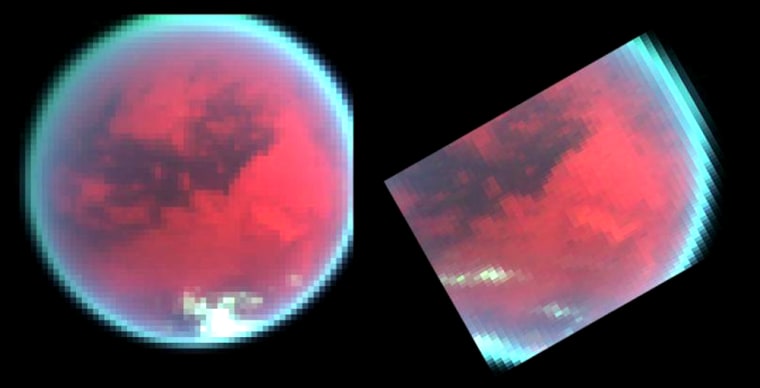• Oct. 20, 2005 |
Titanic weather: The weather on Earth has been pretty unsettling this year, but scientists report today that the weather on Titan, Saturn's biggest moon, is at least as mystifying.
In this week's issue of the journal Science, two research teams take a closer look at Titan's weather patterns, based on fresh data from the Cassini spacecraft as well as the Keck and Gemini telescopes on Earth.
"Titan's weather is very different from Earth's," the University of Arizona's Caitlin Griffith said in a news release based on her team's research. "If you walked past Titan's minus-40-degree-latitude line, you might be showered with liquid natural gas. If you decided to visit Titan's south pole, you might encounter a storm the size of a hurricane which also consists of methane, more commonly known as natural gas. Otherwise, don't expect clouds on Titan."
Griffith's analysis of Cassini data was supported by the observations from ground-based telescopes, which are detailed by a team led by Henry Roe at the California Institute of Technology. Titan's methane clouds appeared to bunch up in a band at 40 degrees south latitude, and at zero degrees and 90 degrees longitude. Roe's team also found that clouds at the mid-latitudes arose and dissipated in the course of one Earth day — in contrast to the clouds seen at the moon's south pole, which lingered for weeks.
So what makes Titan's weather so localized? Both teams suggest that ice volcanoes or geysers are continuously spewing methane gas into the moon's smoggy atmosphere, and sparking formation of the clouds.
Griffith's team says global circulation patterns in Titan's atmosphere may be behind the 40-degree band of clouds, producing a convective phenomenon similar to the clouds that gather around Earth's equator and dump rain on the Caribbean. That scenario happens to fit a climate model for Titan that was developed by Pascal Rannou and colleagues at the University of Paris, Griffith said.
The new findings would explain why Titanic clouds tend to bunch up at a particular latitude — but what about the longitude? Griffith admits that's still a mystery. "What's causing the bunching is unclear, and likely involves unknown features on Titan's still largely unexplored surface," she said.
Unraveling the mysteries of Titan's weather (and Mars' weather) just might give us a better understanding of how our own climate works, because we can now study comparative planetary meteorology. First, we might be able to apply outer-space lessons to our own planet. Then, we might even figure out ways to make Mars or even Titan more livable when we're ready to get off this rock.
• Oct. 20, 2005 |
Scientific roads lead to Pittsburgh: Over the next few days, I'll be at a scientific two-fer in Pittsburgh. First, the National Association of Science Writers will be conducting its annual meeting — and will be rolling out the new edition of "The Field Guide for Science Writers," a compendium to which I contributed a chapter. The NASW meeting morphs into the annual New Horizons in Science briefing, presented by the Council for the Advancement of Science Writing and hosted by Carnegie Mellon University.
My presence in Pittsburgh means I'll have to miss out on some other cool stuff that's happening over the weekend, including the first Space Elevator Games and the Space Frontier Conference. It also means postings to the log might not be as regular as usual. Through next Wednesday, updates will be dependent on time, bandwidth and news developments. I'll be back in the office in a week.
• Oct. 20, 2005 |
Wonder and whimsy on the World Wide Web:
• • •
•
• Oct. 19, 2005 |
Space station snags: It's been a glitchy couple of weeks for the international space station effort. First there was the partial depressurization of a Soyuz crew capsule during its return from the station with a millionaire and two professional astronauts aboard. Today, a Russian cargo craft's thrusters conked out during a maneuver to boost the station's orbit.
On top of those snags, there's the continuing back-and-forth over who will pay the multimillion-dollar Soyuz fare for future NASA astronauts, particularly since the space shuttle fleet won't be back in action by the time the next American is due to come aboard the station in March or so.
Until now, the Russians had agreed to cover the cost, but NASA is supposed to pay the Russians for Soyuz rides from now on. That's a problem, because NASA is currently barred from making such payments by the Iran Nonproliferation Act. As a result, the Russians are holding off on confirming that a NASA astronaut will be part of the next space station crew — at least according to a source quoted by the Interfax-Military News Agency.
"Only two crew members to be launched next year are known for sure now," the source at the Star City cosmonaut training complex said, referring to Russia's Pavel Vinogradov and Brazil's Marcos Pontes. The source did acknowledge, however, that NASA's Jeff Williams was in training along with Vinogradov. Pontes would join them once he cleared the medical exams, the source said.
Chances are that the payment problem will be ironed out by the time Expedition 13 is launched to the station, either because Congress takes action to clear the way for NASA payments, or because the Russians work out some sort of "fly now, pay later" plan.
And chances are that the Russians will cope with the delay in raising the space station's orbit as well.
The original plan called for the Progress cargo craft currently docked to the station to fire its thrusters to raise the station's orbit, as is periodically necessary to counteract atmospheric drag. But Russian news media reported that the thrusters cut out several minutes into the firing.
A spokesman for Russia's Federal Space Agency, Konstantin Kreidenko, told the Itar-Tass news agency that experts were troubleshooting the problem — and indicated it was no big deal. "We will definitely raise the station's orbit. If need be, this operation can be performed by the Progress's main propulsion engines instead of the thrusters," Itar-Tass quoted Kreidenko as saying.
Meanwhile, NBC News space analyst James Oberg cited reports from NASA that the root of the problem was a break in communications with the Russian guidance computers, rather than a malfunction of the thrusters themselves.
Oberg also said he was waiting to hear more about what happened aboard the Soyuz capsule that carried NASA astronaut John Phillips, Russian cosmonaut Sergei Krikalev and millionaire space passenger Greg Olsen from the station back down to Earth last week.
"John Phillips remains the only member of the Soyuz TMA-6 crew who has not publicly given his version of the apparent 'depressurization anomaly' on the Soyuz descent last week," Oberg wrote. "Krikalev and Olsen have candidly spoken out — Phillips remains silent."
• Oct. 19, 2005 |
A black hole’s banquet: Cosmic destruction never looked so good.
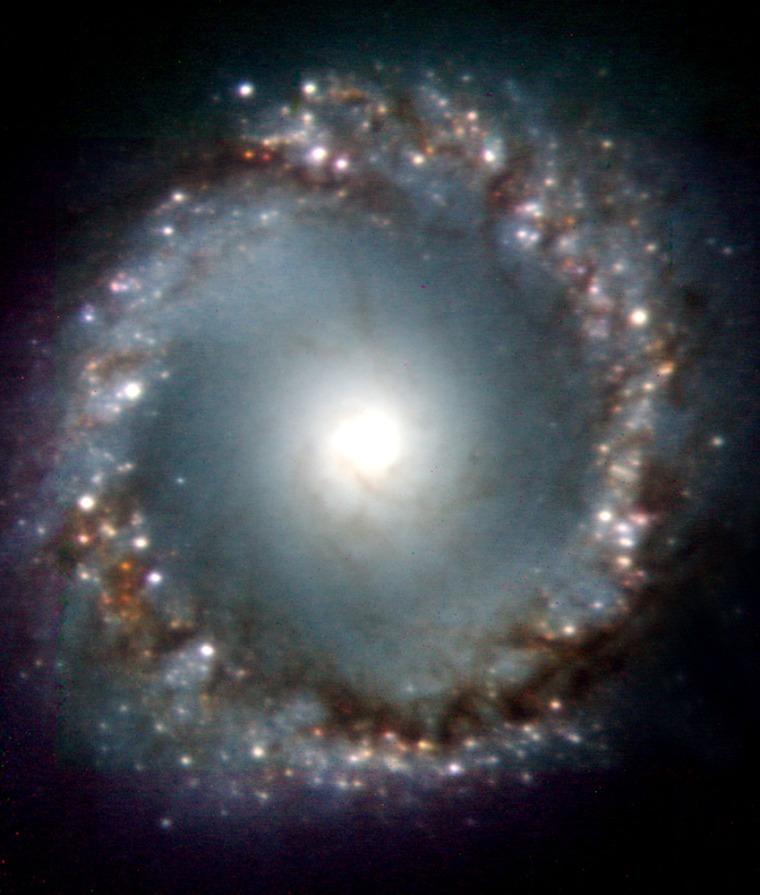
The European Southern Observatory's Very Large Telescope snapped this near-infrared picture of a galaxy's innards circling down toward a supermassive black hole at its center, 45 million light-years away from Earth. The snapshot is actually a close-up of the central region of galaxy NGC 1097 in the southern constellation Fornax, which was pictured last year in a wide-angle shot from ESO.
The earlier photo led astronomers to suspect that a black hole was gobbling away at the galaxy's center, and the new imagery provides further confirmation.
"This is possibly the first time that a detailed view of the channeling process of matter, from the main part of the galaxy down to the very end in the nucleus, is released," Almudena Prieto of Germany's Max-Planck Institute said in this week's ESO image release. Prieto is the lead author of a research paper on NGC 1097, appearing in the October issue of the Astronomical Journal.
By masking out some of the galactic glare, the researchers were able to trace filamentary spirals leading from the star-forming ring into the central point — and in fact the pattern of the tightening spiral matched computer models for what would be expected if gas and dust were indeed swirling into a supermassive black hole. (This image shows the spiral pattern more clearly.)
The image illustrates how scientists look for black holes by what's happening around their edges, since a black hole is so massive that nothing, not even light, can escape from its "event horizon" (unless we're talking about Hawking radiation). This isn't the first time scientists have spotted stuff swirling down a black-hole drain; check out this archived story for another shot looking down a black hole's throat.
• Oct. 19, 2005 |
Quick spin on the scientific Web:
• • •
•
• Oct. 18, 2005 |
Visual tricks and treats: You don't have to wait until Halloween to gather up some cosmic treats — and appreciate a trick or two as well.
Today you can treat yourself to a new batch of images showing Dione, a ghostly moon of Saturn, as it floats in space with the planet and its rings in the background. The international Cassini spacecraft snapped scores of pictures as it flew past Dione last week.
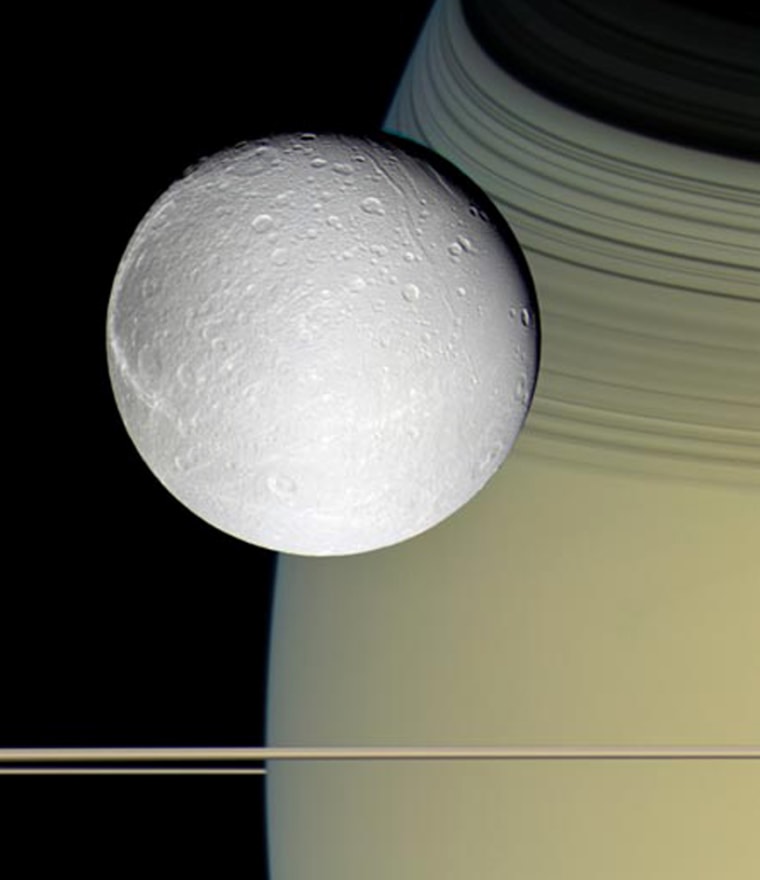
Dione's disk may look as if it's a black-and-white photo superimposed on a butterscotch Saturn, but that's really how the icy moon looks in full color. Saturn's rings are seen almost edge-on, but because of the angle of the sun's rays, individual ringlets cast arcs of shadow on the planet's cloud cover — adding to the eerieness of the scene.
The Dione flyby produced plenty of additional treats, including a zoom-in movie of the encounter; a close-up look at the moon's peaks, craters and mysterious linear channels; and a false-color view that accentuates subtle differences in surface characteristics. Check out NASA's Cassini home page or the Web site for Cassini's imaging team to see still more.
Cassini is due to gather more goodies during its close encounter with Titan on Oct. 28. Before the Cassini mission, Titan's surface was completely hidden from view, due to its obscuring atmospheric haze. But now we're becoming increasingly familiar with Titan's weird rivulets of hydrocarbon gunk, thanks to Cassini's smog-piercing camera system and the historic pictures sent back by the Huygens lander.
During the Oct. 28 flyby, Cassini's radar imager is due to focus on the region where Huygens landed, perhaps picking up additional details. Who knows what treats the Halloween flyby will yield?
At about the same time, Mars will be reaching its own Halloween peak: The Red Planet will come closest to Earth on the night of Oct. 29-30, passing within 43.1 million miles (69.4 million kilometers). Then, on Nov. 7, Mars will be at opposition — meaning that the sun, Earth and Mars would form a straight line, as seen from above. The bottom line is that from now until mid-November, we'll be getting our best view of Mars until the year 2018.
OK, so the view won't be quite as good as it was back in the summer of 2003, when Mars came as close as 34.7 million miles (55.8 million kilometers). But it will be higher in the sky than it was two years ago, as seen from the Northern Hemisphere, and that should provide a sharper image for skywatchers at midnorthern latitudes.
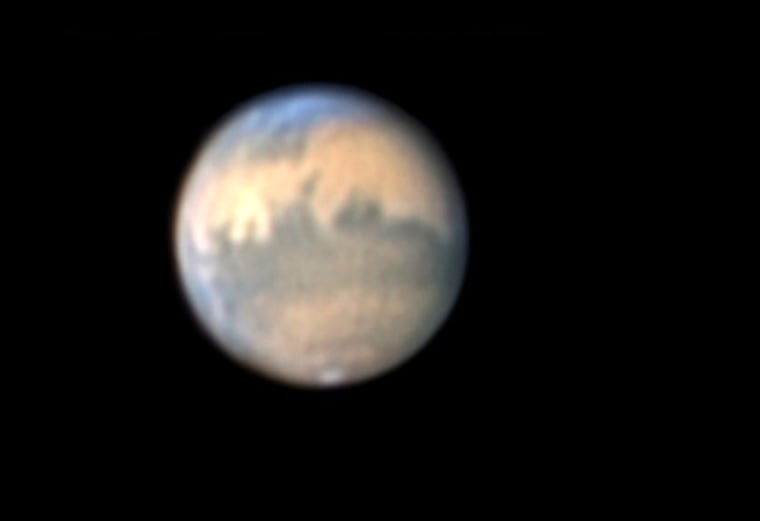
You might recall that there was a bit of a trick played on skywatchers this summer, when a widely circulated e-mail seemed to claim that Mars would be incredibly close to Earth this August. That e-mail actually referred to the 2003 encounter, but many were misled into thinking August was the prime time for viewing Mars. Actually, that prime time is right now.
For an excellent guide to the Mars encounter, check out these tips and charts from Sky & Telescope, and stay tuned for further guidance as Halloween approaches.
• Oct. 18, 2005 |
Scientific smorgasbord on the World Wide Web:
• • •
•
• Oct. 17, 2005 |
Science ... Wow! While some biologists argue over whether living things are so complex they had to be supernaturally designed, others are taking life apart and trying to put it back together in the lab like an old jalopy.
That's the kind of thing that makes "Nova ScienceNOW" host Robert Krulwich literally go wow.
"The key bit of business here is that most people think of living things as amazing, as a miracle. ... But for a subset of people, this is not something so beautiful and mysterious that they just sit and stare," Krulwich said of the latest topic for his public-TV series. "For them, this is more like an automobile, where you can look at the pieces and figure out how it goes."
Artificial life? It's all in a day's wonder for Krulwich, a veteran journalist whose work appears on programs ranging from ABC News' "Nightline" to NPR's "All Things Considered" to PBS' "Nova ScienceNOW," which airs five times a year as part of the "Nova" documentary series.
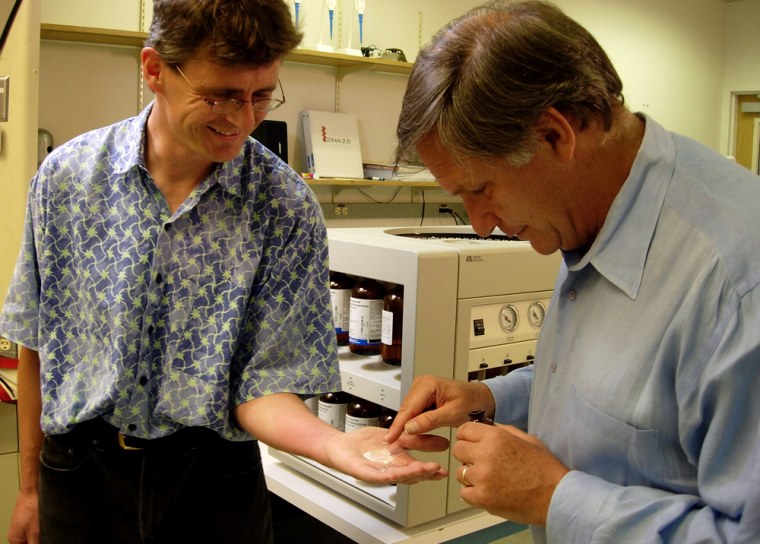
Over the years, Krulwich has developed a knack for coming up with entertaining explanations for economic and scientific concepts that might otherwise seem irreducibly complex, ranging from interest rates to string theory.
Krulwich said the starting point for his kind of story — particularly a "Nova ScienceNOW" story — is often something that makes him say, "Wow, how did they do that?"
"The harder thing is to explain it, [to say] 'Now let's go behind the wonder and look at the machinery,'" Krulwich told me today.
So how does he do that? Krulwich said it's a question of finding "very prestigious learned people" and getting them to use metaphors to explain the key scientific principles in everyday terms. Sometimes, Krulwich has to repeat the process several times, at the risk of having learned people think he's a simpleton.
"Basically, you argue them into a metaphor that they can live with," Krulwich explained.
For Tuesday's "Nova ScienceNOW" episode, Krulwich talked with biochemist David Deamer of the University of California at Santa Cruz, who is trying to reproduce a primordial process by which organic materials might have become surrounded by a protective membrane, perhaps setting the stage for the first biological cells. Krulwich spun up some chemicals with DNA 2.0 President Jeremy Minshull, whose company is trying to reverse-engineer genes and someday perhaps even entire cells. And he spoke with Francis Collins, director of the National Human Genome Research Institute, about the definition of life itself.
There are a lot of "perhapses" and "mights" in all this, and that's exactly what Krulwich is aiming for with "Nova ScienceNOW."
"You're at that interesting place where you think you know something — but it's a little more tentative," Krulwich said. "And that's the basic mood in science."
The other subjects addressed in Tuesday's show carry on that theme of unsettled science:
- Why lightning might actually be sparked by cosmic rays.
- Why we should have known how much damage a hurricane could do to New Orleans.
- Why birds just might be brainier than we once thought.
- Why fish are swimming on the frontier of veterinary medicine.
- And why real aliens, if they exist, probably wouldn't look like at all like they do in the movies.
The entire episode will be accessible online after it airs on TV.
Krulwich is already looking ahead to the next episode, which just might include a story on how viral diseases like bird flu jump from one species to another. He noted that pigs as well as birds appear to play a role in the development of flu viruses hazardous to humans.
"Apparently it's in the pig gut where the virus says, 'Well, let's see, today I think I'm going to be a little bit pig, and a little bit bird and a little bit human,'" he said. "I'm right in the middle of this, but it looks like the pig has got a little factory going on in there."
Krulwich acknowledged that the tentativeness of the scientific process is sometimes hard for the general public to understand — leading some people to conclude either that scientists don't really know the full story, or that there are some things too mysterious to be known.
He said most scientists would probably agree that there's still much that's unknown, but would be deeply suspicious of the claim that some things are unknowable — no matter what scriptures might say. Krulwich, who describes himself as a religious person as well as a science journalist, can see both sides of the issue.
"I'm very comfortable with the idea that some things are not knowable," he said, "but then, I'm not a scientist."
• Oct. 17, 2005 |
Venusian postcards: The planet Venus is like no vacation destination you've ever seen, with sulfuric-acid clouds and rocks that would fry your toes off in an instant. So you probably wouldn't write "Wish you were here" on the back of a Venusian postcard unless you were sending it to your worst enemy.
But there's still a kind of beauty to the hellish world, and that may be what the Planetary Society is aiming for in its "Postcards From Venus" art contest, which is linked to the European Space Agency's Venus Express mission. Following in the footsteps of "Imagining Titan," the contest is soliciting imaginative views of Venus from a bird's-eye perspective.
Between now and Jan. 13, entries are being accepted online and by snail-mail, with winners to be selected in 17-and-under and 18-and-over age categories. The grand prize is a trip to Germany to visit the European Space Operations Center during the orbiter's arrival at Venus next April. Check out the official rules at the Planetary Society's Web site, and may the best art win.
• Oct. 17, 2005 |
Your daily dose of science on the Web:
• • •
•
Looking for older items? Check the . Share your perspective on cosmic subjects with . If you link to this page, you can use or as the address. MSNBC is not responsible for the content of Internet links.
